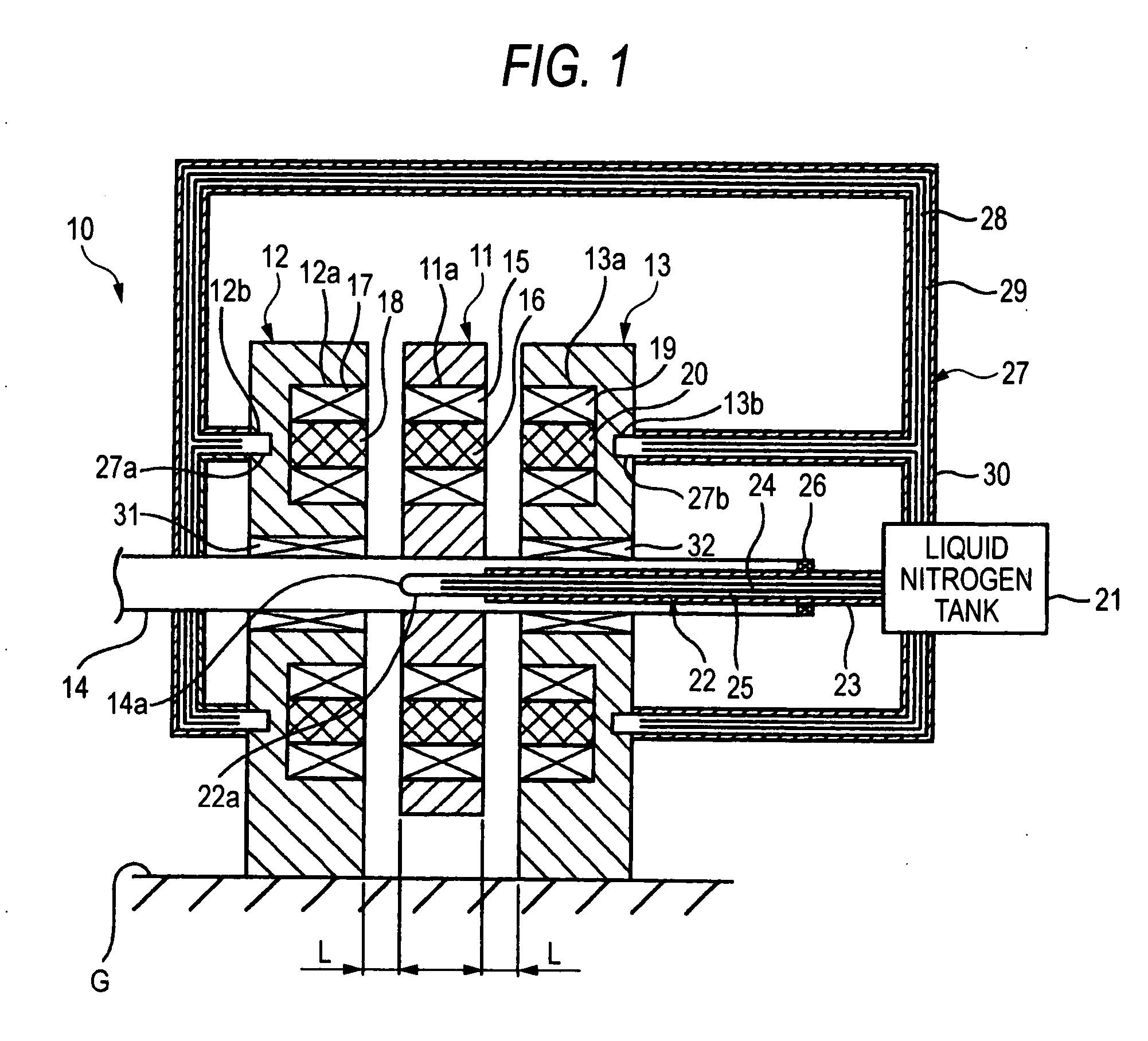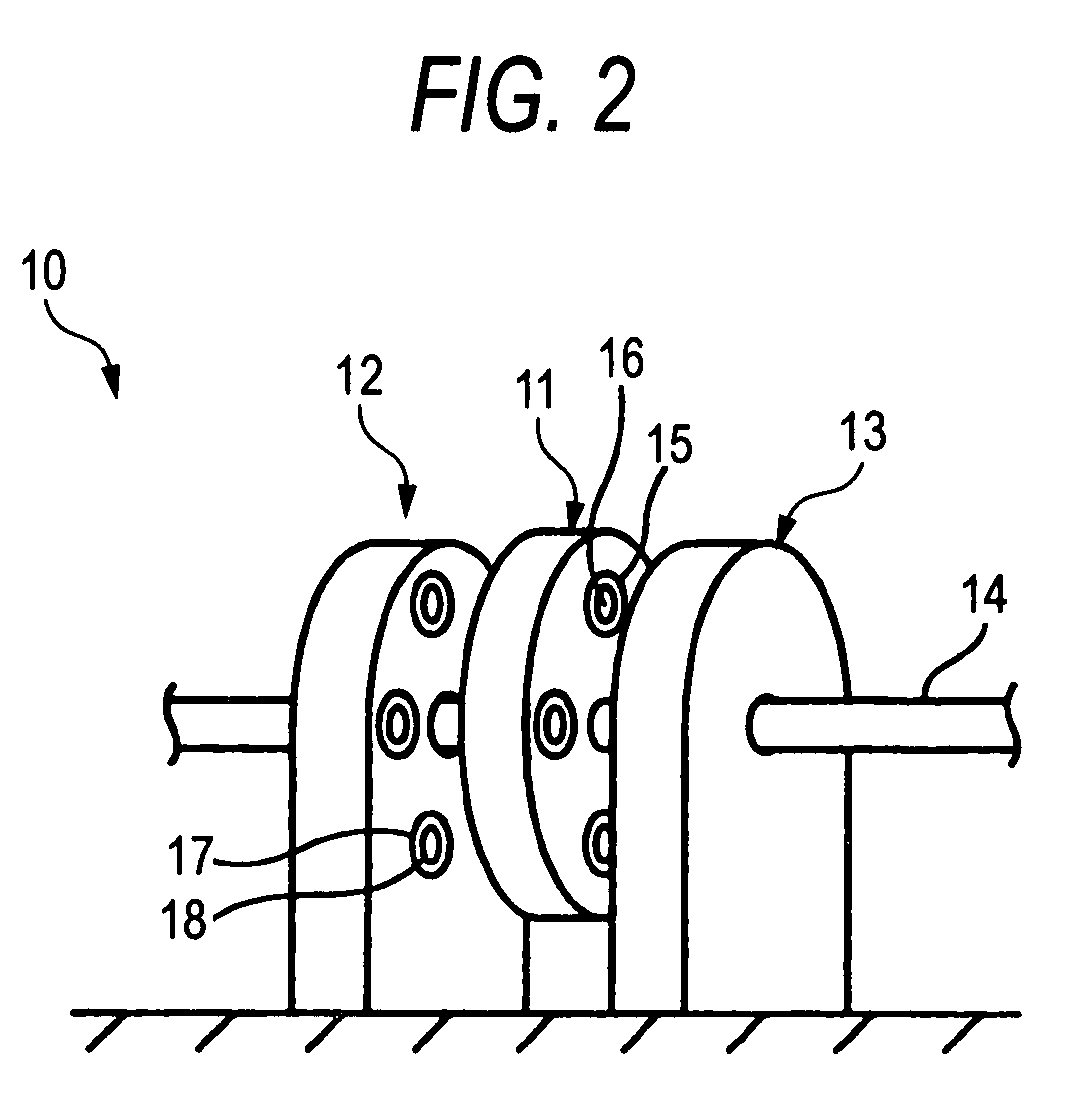Axial Gap Type Superconducting Motor
a superconducting motor and axial gap technology, applied in the direction of superconductor devices, magnetic circuit rotating parts, magnetic circuit shape/form/construction, etc., can solve the problems of motor inevitably increasing, reducing energy efficiency, increasing weight, etc., and achieve high efficiency, large current, and no copper loss
- Summary
- Abstract
- Description
- Claims
- Application Information
AI Technical Summary
Benefits of technology
Problems solved by technology
Method used
Image
Examples
first embodiment
[0058]FIGS. 1 and 2 show an axial gap type superconducting motor 10 according to the invention. The axial gap type superconducting motor 10 has a pair of stators 12 and 13 disposed to face each other on both sides of a rotor 11 in an axial direction of the rotor 11 fixed to a rotary shaft 14. The rotary shaft 14 fixed to the rotor 11 is hung so as to pass through bearings 31 and 32 of the stators 12 and 13.
[0059] The rotor 11 is formed in a disk shape, and the rotary shaft 14 is fixed to the rotor 11 so as to pass through the center thereof. The rotor 11 has a plurality of coil attachment holes 11a, which are provided at regular intervals in a peripheral direction on the outer peripheral side thereof, and a plurality of field coils 15 buried in the coil attachment holes 11a, the field coils 15 being made of a superconductive material. As such, the plurality of field coils 15 are attached at regular intervals in a peripheral direction around the axis of the rotor such that the magnet...
second embodiment
[0071] Next, the invention will be described.
[0072] As shown in FIG. 3, a difference from the first embodiment is that flux collectors 35 disposed in hollow parts of the field coils 15 of the rotor 11 are buried so as not to project from the end surfaces of the field coils 15.
[0073] If this configuration is adopted, the flux collectors 35 do not project from the leading end surfaces of the field coils 15. Thus, an attraction force caused by a magnetic force is hardly generated between the stators 12 and 13 during assembling, etc. Further, any collision between the rotor 11 and the stators 12 or 13 does not occur. Therefore, positioning is easily performed while a gap is maintained at a set distance.
third embodiment
[0074] Next, the invention will be described.
[0075] As shown in FIG. 4, a difference from the first embodiment is that air gaps S are provided in the hollow parts of the armature coils 17 and 19 of the stators 12 and 13.
[0076] If this configuration is adopted, magnetic bodies are not present in the hollow parts of the armature coils 17 and 19 facing the flux collectors 16 of the rotor 11, and an attraction force caused by a magnetic force between field bodies is not generated during assembling, etc. Thus, positioning can be easily performed while the gap between the rotor 11 and the stators 12 or 13 is maintained at a set distance.
[0077] In general, when flux collectors are disposed in hollow parts of coils, a magnetic field is strengthened. As shown in FIG. 5, however, a magnetic flux does not almost increase after a current exceeds a certain value. Rather, when flux collectors are not provided, the magnetic field tends to be strengthened. That is, the axial gap type superconduct...
PUM
 Login to View More
Login to View More Abstract
Description
Claims
Application Information
 Login to View More
Login to View More - R&D
- Intellectual Property
- Life Sciences
- Materials
- Tech Scout
- Unparalleled Data Quality
- Higher Quality Content
- 60% Fewer Hallucinations
Browse by: Latest US Patents, China's latest patents, Technical Efficacy Thesaurus, Application Domain, Technology Topic, Popular Technical Reports.
© 2025 PatSnap. All rights reserved.Legal|Privacy policy|Modern Slavery Act Transparency Statement|Sitemap|About US| Contact US: help@patsnap.com



